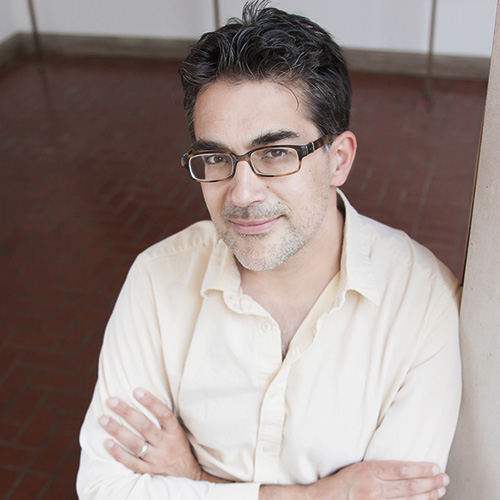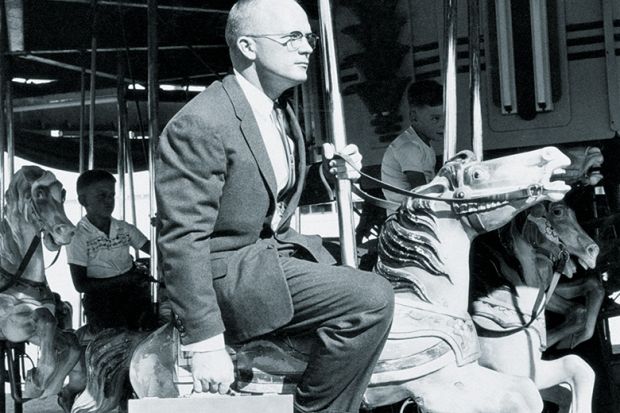For an academic, midlife has an odd feel. Life is linear; university life is cyclical. Each year, amid the sweet, melancholy, annual death that is autumn, the cycle begins again. You are a year older but are surrounded by young people who are not.
There is another, complicating factor. The managerialism of the modern university is project-driven. Its audits and assessment exercises consume much time and worry and then vanish like snow, to be replaced by something worse. After you have been through enough of these iterations, the organisational amnesia – in which every year becomes year zero and we are always “moving forward” – starts to feel quite surreal. Meanwhile you welcome new colleagues, attend retirement dos and go to funerals. You are “moving forward” all right – in one direction.
We midlife academics carry on doing the same job as best we can. But we now know that we are auditioning for another role: the academic ghost we will one day be, haunting the corridors and rattling our chains. Our role model is Stoner, the freshman-composition drone at the University of Missouri and eponymous hero of John Williams’ classic novel. At 42, with a failed marriage and failed career, he “could see nothing before him that he wished to enjoy and little behind him that he cared to remember”.
Kieran Setiya is nothing like Bill Stoner. A professor of philosophy at the Massachusetts Institute of Technology with a happy family life, he recognises his good fortune. And yet, six years ago, at the age of 35, he began to think of the life that he had worked so hard to build and to see it as a series of diminishing returns. There was “something hollow in the prospect of doing more of it, in the projected sequence of accomplishments stretching through the future to retirement, decline, and death”. He became filled with “a disconcerting mixture of nostalgia, regret, claustrophobia, emptiness, and fear”.
First-world problems, you might think, and Setiya has anticipated this objection. The midlife crisis is partly a phenomenon of the affluent West and, at least as a named entity, fairly new. Only in 1965 did the Canadian psychoanalyst Elliott Jaques publish the paper that coined the phrase. The way it has entered the vernacular hardly invites precision and rarely elicits sympathy. Whenever I hear that someone is “having a midlife crisis”, I invariably hear the implication that this is a self-indulgent (and usually male) vanity.
But the midlife crisis, as Setiya shows, is real and gender-unspecific. Recent studies identify a U-curve of human happiness, with depression and anxiety peaking at age 45. Some of this may simply mean that “shit happens in midlife”, to our health and our work and family responsibilities, and we call it a midlife crisis because we can. But the crisis also has deeper existential causes.
Our lives, Setiya argues, are founded on incommensurable values, which cannot be evaluated using a simple felicific calculus. He grew up wanting to be a poet, then wondered about following his father into medicine. Being a poet or a doctor cannot be compared with being a philosophy professor, for none of these fates subsumes or cancels out the others. Trying to choose between incommensurable values inevitably generates midlife regret and a feeling of missing out. It is the price we pay for the plurality of our values and our freedoms.
Setiya is happy to call Midlife a self-help book, even if he concedes that he has written it partly to help himself. It is a model for how to write philosophy clearly and non-technically without lapsing into banality or truism. Setiya writes enlighteningly about his own midlife crisis without it ever sounding like a whine. His voice throughout is warm, lucid and sane.
For a self-help book, it certainly refuses easy consolations. Some of the advice that Setiya gives is, he must know, no help at all. In the light of one’s physical decrepitude, he advises anticipatory nostalgia. “Imagine how you will feel about the face in the mirror, the body you inhabit today, when you look back from ten or twenty years,” he writes. “It could and will be worse.” (Thanks.) He also argues that cognitive therapy has no answer to the perfectly rational fear of death. (Thanks again.)
But some of Setiya’s advice is genuinely useful. If you think, as he does, that you would have been better off as a doctor, then recognise that you are ignorant of the texture of such a life, “the enveloping substance of the work that makes it so worthwhile”. This “amplitude of life, its unfathomable particularity” is what is missing from our midlife regrets. The answer is to focus on the rich and irreducible details of our actual lives. “Do not weigh alternatives theoretically,” he writes, “but zoom in: let the specifics count against the grand cartoon of lives unlived.”
Setiya also makes a distinction – especially useful, I suspect, for academics – between telic and atelic activities. The former aim at terminal states; the latter have no end but are valuable in themselves. Many academic projects, such as publishing articles and applying for grants, are telic. To do them well “is to complete them and so to eliminate meaning from your life”. The best one can feel is what Setiya calls “the emptiness of satisfied desire”.
His advice is not to spend more time doing obviously atelic activities such as going for walks or sitting in parks. (I suspect he knows his neurotic peers too well.) Rather, if you overinvest in telic activities, the solution is “to love their atelic counterparts, to find meaning in the process, not the project”. Only thus will we escape “the self-subversion of the project-driven life”.
It seems to me that Setiya, as a philosopher, misses something else about middle age: it turns us all into anthropologists. “In middle age a liberation takes place,” the poet Michael Hamburger wrote in his memoir, A Mug’s Game. A “fourth factor” appears alongside the id, ego and superego, “smiling or unashamedly laughing at their silly little squabbles”. This fourth factor is a relativist not an absolutist, a comedian not a tragedian. The middle-aged are converts to life’s essential absurdity.
Our students are often described as “digital natives” – not always true, in my experience. But students are natives in the sense that they are too young to know that the reality they swim in was once different and will be different again. In midlife, the world feels slightly skewed, its languages and behaviours newly strange. The rituals of the modern university begin to feel as curious as the rituals of the Trobriand Islanders must have seemed to Bronisław Malinowski (although not as much fun).
The midlife academic is sailing to Byzantium, but may be stuck halfway, feeling adrift and disoriented. Diana Athill writes beautifully about old age as “like coming out onto a high plateau, into clear, fresh air, far above the antlike bustle going on down below me”. That is the state I hope one day to attain. I will be an unembittered, obliging onlooker, with only benign feelings towards those still stuck in the country that, as Yeats wrote, is not for old men. If anyone knows a way to attain this state, please tell me how.
Joe Moran is professor of English and cultural history at Liverpool John Moores University.
Midlife: A Philosophical Guide
By Kieran Setiya
Princeton University Press, 200pp, £18.95
ISBN 9780691173931
Published 15 October 2017

The author
Kieran Setiya, professor of philosophy at the Massachusetts Institute of Technology, was born in Hull and studied philosophy at Jesus College, Cambridge, where he found himself part of “an immediate, close-knit intellectual community. It was the first time I had been around other people who loved philosophy and it was wonderful. [It gave] me the confidence to think it wasn’t crazy to pursue a career in academia.”
Going on to graduate school at Princeton, Setiya expected to work on metaphysics, yet “it was in a seminar with Harry Frankfurt – now famous as the author of On Bullshit – that I was gripped by moral philosophy [and] ‘action theory’, the part of philosophy concerned with what it is to act for reasons. Since then, more or less everything I have written has been about the idea of a reason to act, what it means to ask ‘How should I live?’”
His first sustained attempt to write for a general audience, Midlife arose directly out of Setiya’s “own experience of malaise around midlife. Having jumped through the demanding hoops of the academic career, I stopped to ask ‘What next?’, and realised with dismay that I no longer felt the thrill of philosophy I had felt in college. Philosophy still seemed worth doing – writing the next article, teaching the next class – but the magic was gone. The irony was hard to miss: here I was, a philosopher working on the question ‘How to live?’ feeling baffled about how to live.”
Since finishing the book, Setiya has been writing “a series of articles about love, respect and the value of humanity” while also “thinking about the ethics of climate change”. Yet his main goal has been “trying to retrieve the joy of doing philosophy for its own sake. I would like to think less about where I am going and more about how to appreciate where I am.”
Matthew Reisz
POSTSCRIPT:
Print headline: The age of absurdity
Register to continue
Why register?
- Registration is free and only takes a moment
- Once registered, you can read 3 articles a month
- Sign up for our newsletter
Subscribe
Or subscribe for unlimited access to:
- Unlimited access to news, views, insights & reviews
- Digital editions
- Digital access to THE’s university and college rankings analysis
Already registered or a current subscriber? Login




